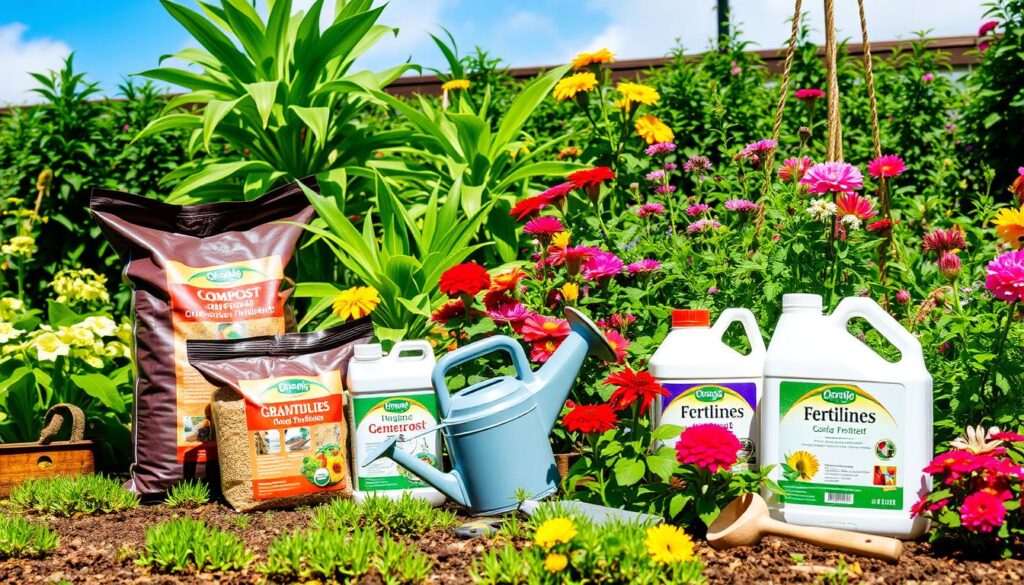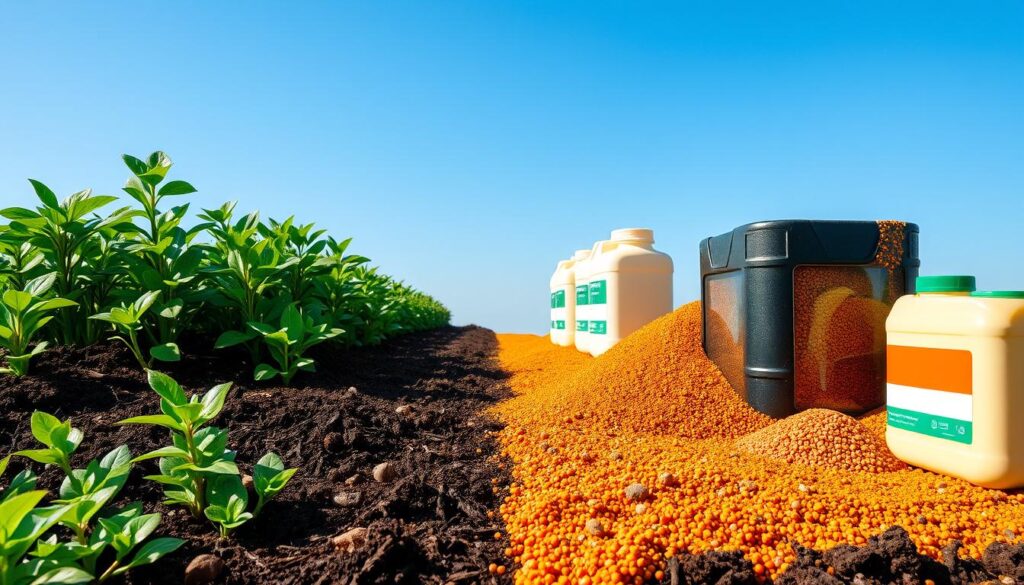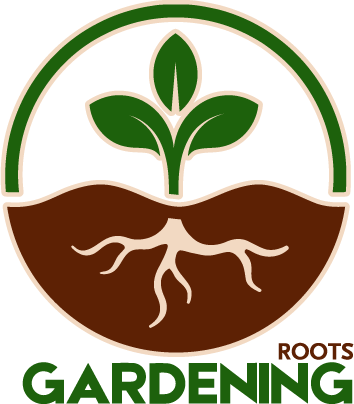Table of Contents
Did you know the global fertilizer market is set to hit $265 billion by 2027? Fertilizers are key for plant growth and big harvests. This guide will teach you the fertilizer basics for beginners and how to keep your plants healthy.
Whether you’re new to gardening or have years of experience, knowing about fertilizers is important. We’ll explore the differences between organic vs. inorganic options and granular vs. liquid formulas. You’ll learn how to choose the best fertilizer for your garden.
By the end of this article, you’ll know how to make smart choices about garden fertilization. You’ll also learn best practices for using fertilizers. Get ready to create a lush, nutrient-rich garden that will impress your neighbors!

Key Takeaways
- The global fertilizer market is projected to reach $265 billion by 2027, highlighting the importance of fertilizers in modern agriculture and gardening.
- Understanding the fundamentals of fertilizers, including the differences between organic and inorganic options, as well as granular and liquid formulas, is vital for successful plant growth.
- Choosing the right fertilizer for your garden’s unique needs requires considering factors like soil testing and plant-specific requirements.
- Adopting best practices for fertilizer application, such as proper timing and frequency, is essential for ensuring the optimal nourishment of your plants.
- Promoting soil health through the use of organic fertilizers and practices like improving soil structure can contribute to a thriving, sustainable garden.
Introduction to Fertilizers
As a beginner gardener, knowing about fertilizers is key for a healthy garden. Fertilizers give plants the nutrients they need to grow and produce well. We’ll explore what fertilizers are and why plants need them.
What Are Fertilizers?
Fertilizers are special soil additives with nutrients like nitrogen, phosphorus, and potassium. These nutrients help plants grow and produce flowers and fruits. Fertilizers can be organic or inorganic, each with its own benefits.
Why Do Plants Need Fertilizers?
Plants need a mix of nutrients to grow well. Soil can lose these nutrients over time, making it hard for plants to get what they need. Fertilizers add back these nutrients, helping plants grow strong and healthy.
Adding the right fertilizers to your garden can greatly improve your plants’ health. Learning about fertilizers is the first step to a lush and productive garden.

Types of Fertilizers
Choosing between organic and inorganic fertilizers is key for your garden. Knowing the pros and cons of each helps pick the right one for your garden.
Organic vs. Inorganic Fertilizers
Organic fertilizers come from natural sources like plants or animals. They release nutrients slowly, improving soil over time. They’re good for the environment and soil health.
Inorganic fertilizers, made in labs, give plants a quick nutrient boost. But, they might not be as good for soil health as organic options.
| Organic Fertilizers | Inorganic Fertilizers |
|---|---|
| Derived from natural sources | Manufactured in a lab |
| Gradual nutrient release | Immediate nutrient boost |
| Improve soil structure and microbiome | May not have long-term soil benefits |
| Sustainable and eco-friendly | Potential environmental concerns |
Think about your gardening goals and plant needs when choosing. Organic or inorganic, knowing the differences helps pick the best for your garden.

Granular vs. Liquid Fertilizers
You have two main choices for your garden: granular or liquid fertilizers. Each has its own benefits and drawbacks. Knowing the differences helps you pick the right fertilizer for your garden.
Granular fertilizers are solid and slow-release. They are scattered on the soil. They take longer to break down but provide nutrients steadily. They’re great for big gardens or mature plants because they release nutrients slowly.
Liquid fertilizers are water-soluble and quickly absorbed. They give plants an immediate nutrient boost. They’re perfect for young plants, container gardens, or spot treatments. They’re also easy to apply and can be mixed with water.
| Granular Fertilizers | Liquid Fertilizers |
|---|---|
| Slow-release nutrients | Immediate nutrient boost |
| Suitable for larger gardens and established plants | Ideal for younger plants and container gardens |
| Requires more time to break down and be absorbed | Quickly absorbed by plants |
| Scattered across the soil surface | Can be mixed with water for even application |
When picking between granular and liquid fertilizers, think about your gardening goals. Consider the size and age of your plants and their nutrient needs. By understanding these differences, you can choose the best way to nourish your plants and grow a thriving garden.
Choosing the Right Fertilizer
Choosing the right fertilizer is key for a lush, healthy garden. You need to know about soil testing and what nutrients your plants need.
Soil Testing
Start by testing your soil. This tells you about your soil’s pH, nutrients, and any missing nutrients. With this info, you can pick a fertilizer that fits your soil’s needs.
Plant Needs
- Each plant needs different nutrients. Some love rich soil, while others prefer balanced soil. Think about your plants’ needs when picking a fertilizer.
- For example, tomatoes and peppers need more phosphorus for fruit growth. Leafy greens, on the other hand, do well with more nitrogen for leaves.
By understanding the needs of your soil and plants, you can choose the most suitable fertilizer. This way, you’ll get the most out of your garden. The focus is on selecting the best fertilizer for your garden while ensuring your soil remains healthy.
“The foundation of successful gardening lies in recognizing the specific needs of your soil and plants. With the right garden fertilization tips, you can unlock the full soil health and fertilization of your garden.”
Fertilizer Basics for Beginners: What You Need to Know
As a beginner gardener, knowing about fertilizers is key to a thriving garden. Whether you want to grow veggies, flowers, or a green lawn, learning about fertilization is vital. We’ll cover the basics to help your plants get the nutrients they need.
It’s essential to understand that not all fertilizers are alike. Organic fertilizers come from natural sources like animal manure and compost. On the other hand, inorganic fertilizers are made from chemicals. The right choice for your garden depends on your needs and preferences.
Also, consider the type of fertilizer. Granular fertilizers are spread on the soil and release nutrients slowly. Liquid fertilizers are mixed with water and absorbed quickly by plants. Choose based on your plants’ growth stage and desired results.
| Characteristic | Organic Fertilizers | Inorganic Fertilizers |
|---|---|---|
| Source | Natural (e.g., compost, manure) | Synthetic, chemical-based |
| Nutrient Release | Slow, gradual | Rapid, immediate |
| Environmental Impact | Generally more environmentally friendly | May have a higher environmental impact |
| Cost | Typically more affordable | Often more expensive |
The best fertilizer for your garden depends on your soil, plants’ needs, and gardening goals. By learning about fertilizers, you’ll create a garden that’s full of life and beauty.
“Fertilizers are the foundation of a healthy, productive garden. Understanding these fundamental principles can empower you to maximize the potential of your plants.”
Application Techniques
How you apply garden fertilizers can greatly affect their success. Let’s look at two common methods: broadcast spreading and foliar feeding. These techniques help you feed your plants well.
Broadcast Spreading
Broadcast spreading is a straightforward way to use granular fertilizers. Just spread the fertilizer evenly over your plants. This method is great for lawns, making them look lush and even.
To spread, use a spreader. Move it in overlapping paths for full coverage. Always follow the amount to use as shown on the fertilizer package.
Foliar Feeding
Foliar feeding means spraying liquid fertilizer on your plants’ leaves. This method gives nutrients fast, helping weak plants quickly. It’s perfect for plants that need a quick boost.
For foliar feeding, use a spray bottle or sprayer. Make sure to cover the leaves well, including the underside. Always follow the label for how to mix and apply.
The choice between broadcast spreading and foliar feeding should be based on the specific needs of your plants. Remember, timing, how often, and watering is key for fertilizing your garden right.
“Recognizing the specific needs of your plants and using the appropriate techniques to fulfill those requirements, is the key to effective garden fertilization.”
Best Practices for Fertilizing
Timing and frequency are key when fertilizing your garden. The right amount at the right time boosts plant growth. Knowing how much water plants need to absorb nutrients is also important.
Timing and Frequency
The best times to fertilize are spring and fall. Plants grow well and absorb nutrients easily during these seasons. Fertilize every 4-6 weeks in the growing season. Adjust based on your plants’ needs and soil.
Watering Requirements
Plants need enough water to use fertilizer nutrients. Thoroughly water your plants after fertilizing to ensure the nutrients penetrate the roots. Keeping the soil moist helps your garden grow better.
| Best Practices for Fertilizing | Recommendations |
|---|---|
| Timing | Apply in spring and fall |
| Frequency | Every 4-6 weeks during growing season |
| Watering | Thoroughly water after applying fertilizer |
Follow these tips for a healthy garden. Best practices for fertilizing, garden fertilization tips, and caring for soil health and fertilization are essential. They help your garden thrive.
Organic Fertilizer Ingredients
Organic gardening thrives on the right ingredients in organic fertilizers. These natural materials feed plants and boost soil health. Let’s look at common organic fertilizer ingredients and how they help your garden.
Organic vs. Inorganic Fertilizers: Organic fertilizers come from plants or animals. Inorganic fertilizers are made in labs. Organic fertilizers release nutrients slowly as they break down. Inorganic fertilizers give a quick nutrient boost.
Here are some top organic fertilizer ingredients:
- Bone meal is made from ground animal bones, promoting healthy root and flower development because it’s high in phosphorus.
- Poultry Manure: Chicken, turkey, or duck manure, a balanced mix of nitrogen, phosphorus, and potassium.
- Sulfate of Potash: A natural mineral, high in potassium for plant vigor and disease resistance.
- Feather Meal: Ground-up poultry feathers, slow nitrogen release for plants.
- Fish Meal: Ground-up fish, rich in nitrogen and trace minerals.
- Blood Meal: Dried and powdered animal blood, quick nitrogen for plants.
These ingredients not only feed the soil but also help break down organic matter. They keep the soil’s microbial health strong. This leads to better nutrient cycling and plant growth. Knowing these benefits helps you choose the best for your garden’s health and growth.
Soil Health and Fertilization
Healthy soil is crucial for a flourishing garden. Fertilization is vital for soil health. It helps the soil microbiome, which is full of microorganisms that plants need to grow.
Improving Soil Structure
Good soil structure is essential for plants. It lets them get the nutrients, air, and water they need. Adding compost or manure improves the soil, making it better for microbes and water.
Feeding the Soil Microbiome
The soil microbiome is a complex ecosystem. Organic fertilizers, like those from plants or animals, feed it. These microbes break down the organic matter, giving plants the nutrients they need.
FAQ
What are the main types of fertilizers?
There are two main types of fertilizers. Organic fertilizers come from natural sources like animal manure and compost. Inorganic fertilizers, on the other hand, are made in labs and have synthetic nutrients.
What’s the difference between granular and liquid fertilizers?
Granular fertilizers are dry and you sprinkle them on the soil. Liquid fertilizers are water-based and can be mixed into the soil or sprayed on plants. Granular fertilizers release nutrients slowly, while liquid fertilizers give a quick boost.
How do I choose the best fertilizer for my garden?
To pick the right fertilizer, think about your soil type and plant needs. Organic or inorganic options are also important. Get your soil tested to know its nutrient levels and pH. Then, choose a fertilizer that matches your plants’ needs and soil conditions.
When and how often should I fertilize my garden?
Fertilizing timing and frequency vary by plant type and season. Generally, fertilize in early spring and every 4-6 weeks during the growing season. Always follow the product’s instructions for application rates and timing.
What are the benefits of using organic fertilizers?
Organic fertilizers are great for your garden. They improve soil health and structure by feeding the soil microbiome. They release nutrients slowly, supporting your plants over time. Plus, they’re better for the environment than synthetic options.
How do I apply fertilizer properly?
Always follow the manufacturer’s instructions when applying fertilizer. For granular fertilizers, use a spreader to evenly distribute them. Liquid fertilizers can be applied with a hose-end sprayer or mixed into the soil. Water the area well after application to help nutrients absorb.


1 thought on “Fertilizer Basics for Beginners: What You Need to Know.”
Comments are closed.